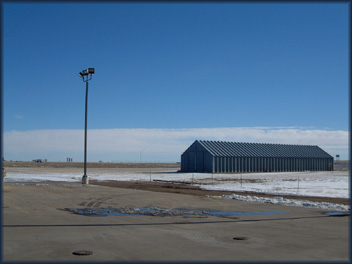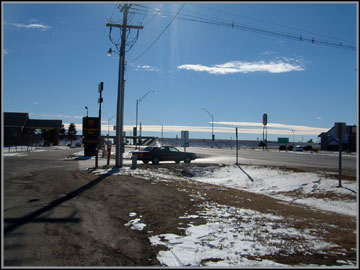THE HIDDEN SEEDS OF WINTER SOLSTICE
(12.23.02) Up here in the northern hemisphere, the days have grown short, just in time for
all those holiday parties and shopping trips and familial obligations, right as
we're wishing for a few extra hours to get everything done. I can hardly believe
it when the dusk's mutedness drops as early as 5 pm. Before I'm even home, it's
dark and I'm bundled up in my hat and a heavy coat. In case you hadn't noticed,
winter has demanded its welcome. The season began officially this past Saturday
evening (Dec. 21), as the sun moved from Sagittarius into Capricorn. This movement
signals the winter solstice, the shortest day of the year in locations north of
the equator. Despite the coldest months of winter still ahead, we have increasing
daily amounts of sunlight to look forward to from now until June.

The earth's movements occur along two distinct paths—the equator, the plane of the earth's daily rotation, and the ecliptic, the plane of its annual orbit around the sun. Twice a year, on the spring and fall equinoxes, these planes intersect, marking the beginning of their respective seasons and, in the case of the spring equinox, the beginning of the astrological year. Solstices, meanwhile, represent the extremes of declination, or the moments of furthest distance between the orbit and the equator, during which times the sun spends its longest time over head (summer solstice) or hidden from view (winter solstice). These four turning points—spring and fall equinoxes, summer and winter solstices—symbolize the connection between our two main time-cycles, the day and the year. Thus, they have been commemorated with seasonal celebrations and rituals by different cultures throughout history, and they've also formed the basis for the ongoing development and study of astrology.
In the weeks building up to the winter solstice, our view of the sun grows weaker in intensity and colder in temperament. When winter solstice finally arrives, we have subconsciously grown to wonder whether the sun's light and warmth will ever return. This is the underlying structure of feeling associated with winter solstice—a deep-seated fear that the sun's power is dead to us, that we lack the resources necessary to make it through the long coming winter. Capricorn, the zodiac sign of winter solstice, fits this emotional scenario well, with its earthy seriousness and a practical, ambitious sensibility for doing whatever needs to be done in order to succeed. Capricorns rarely shy away from engaging with adversity and difficulty, whether through putting messy feelings on the back-burner so they can push on with the hard work at hand, or through wallowing in the fear by turning it back on themselves and feeling guilty or self-critical for never being good enough. Capricorn is a sign prone to depression, with an unceasing awareness of how any current situation always pales in comparison to its ideal potential. And yet, Capricorn is also the sign of the father archetype (ruled by old man Saturn) who grants us discipline, maturity and wisdom through this continued exposure to the harsh elements of the outer world.

At winter solstice time, we are reminded that the great Father figure, like all of us, began life as a baby. We celebrate Christmas on Dec. 25, just a few days into winter, though historians assert it is highly unlikely that Jesus was actually born on this day. Instead, this religious observance coincides with earlier pagan solstice festivities which also celebrated the archetype of the sacred child. Winter solstice begins the six-month period of waxing, or increasing, light in the annual cycle, so, in a sense, it serves as a solar "new moon". During the winter, the earth holds new seeds for future growth below its hard, cold surface. Though we cannot see evidence of these seeds, their slow process of germination and development is beginning. It will start to blossom by early spring, reaching its full culmination by summertime. This matches the Capricorn method of patient, strategic action, which starts out invisible and then emerges with a carefully erected world of enduring strength. Through the images of the baby Jesus and other sacred children, we get in touch with our own infinite potential to do and become anything, to transcend our current circumstances. If we choose, we can emulate these holy archetypes and strive to lead godlike lives, embodying challenging sacrifices to become our own saviors.
With the colder weather, darker skies and hidden initiations of new growth, this time of year is perfect for some hibernation, turning our focus inward and retreating a bit from social obligations. Sure, we may still have Christmas dinners and New Year's Eve parties to attend, but in between and in the weeks following, it's okay to take it slow and adapt to the seasonal atmosphere. As I wrote last week, the reflexive mood favors checking in on our progress and making adjustments as necessary. And if we look at the winter solstice chart as an indication of the season ahead, those same aspects I discussed last week—Saturn trine Uranus, and Jupiter trine Pluto—will continue to represent the general climate of the next few months. Continue to reflect on how these are affecting your lives, and figure out whether you are taking sufficient advantage of their positive flowing energies. Also, be aware that Mercury turns retrograde for three weeks starting Jan. 2, extending its stay in Capricorn through Feb. 12. This emphasizes the need for quiet, restrained planning and revising during the next month or so. Fix your eye on the long-term prize, and systematically figure out how you're going to get there from here. You know better than to expect easy-going, but there's something strangely appealing about the effort and the deferred gratification ahead, necessary to succeed. And after all that immediate gratification of presents and big holiday meals and champagne-induced New Year's tidings, won't it be about time to buckle down and return to normal life?
Have a happy holiday season, and I'll catch up with you again in 2003!


